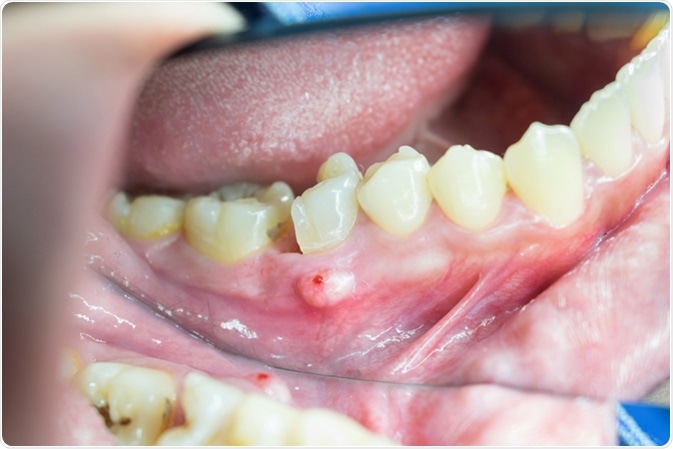An abscess is a confined pocket of pus that builds up within the body. A dental abscess forms within the teeth, in the gums or even the bone holding the tooth in place. A periapical abscess is located at the end of a tooth. A periodontal abscess is located in the gums.

Image Credit: Trailak Amtim / Shutterstock
Both are caused by a bacterial infection and tend to be quite painful. A dental abscess should be shown to a dentist immediately, as it will not heal on its own. It will need medical intervention and treatment. Also if it is not contained, it may spread to other parts of the mouth.
In rare cases, the abscess may not be painful. The individual may not seek medical help immediately if this is the case. However, it can be extremely damaging to the body if the pus is not drained out. The area will grow worse as it becomes swollen and causes bleeding in the mouth.
dental abscess drainage...Abscess tooth removal
How is a Dental Abscess Caused?
If an infection is detected by the body’s immune system, it sends white blood cells to the location. As these cells combine with the infected cells in the tissue, they create the yellowish fluid known as pus. As the pus continues to accumulate in the affected area, the swollen lump of the abscess is formed.
The formation of a dental abscess is triggered by many different types of microbes. They are usually anaerobes such as anaerobic cocci, Prevotella, Fusobacterium species, and facultative anaerobes, such as viridans group streptococciand the Streptococcus anginosus group.
These are identified as pathogens by the immune system and the white blood cells are activated to combat them. The resulting inflammation is painful to the patient and can cause a number of associated dental conditions.
How is a Periapical Abscess Formed?
A periapical abscess is formed when bacteria in the plaque infects the enamel of the tooth. It results in the formation of tiny holes caused by the tooth decay, known as dental caries. The caries goes through the enamel and dentine, which is the soft layer of tissue under the enamel.
By this stage, the tooth is sensitive to hot and cold food or drink, which triggers a painful sensation. Should the caries still not be treated, it will reach the pulp or centre of the tooth. Pulpitis is the condition where the pulp chamber is infected.
If still not treated, the infected pus in the pulp will reach the alveolar bone. This is the bone in the jaw which surrounds and supports the tooth. The infection will infiltrate the bone and the periapical abscess will be formed. This is even more painful than having caries on the enamel and dentine.
How is a Periodontal Abscess Formed?
The tissue in the gum which is infected by the bacteria in plaque will soon become red and swollen. As the infection spreads through the gum, the area around the root of the tooth becomes inflamed. The tooth separates from the gum causing a gap between them.
The space between the tooth and the inflamed gum is called a periodontal pocket. It is here that the bacteria begin to multiply. The white blood cells rush to fight the colonization of the bacteria and a pocket of pus is formed.
As the quantity of pus begins to build up in the periodontal pocket, an abscess is formed. Besides infections, periodontal abscesses can be caused due to dental procedures that accidentally create periodontal pockets. Even without periodontitis, gum damage may occur leading to the formation of a periodontal abscess.
Treating Dental Abscesses
The pus in the abscess has to be removed surgically. For a periapical abscess, a root canal treatment will allow the dentist to drain the pus from the pulp of the tooth. Then a filling will be inserted to ensure there is no space for bacterial infection to reoccur. In some cases, the decay may be so much that the tooth may have cracked and broken into pieces. The only option here is to have the tooth extracted completely.
For a periodontal abscess, the dentist will remove the diseased tissue, then attempt to reshape the gum in order to eliminate the periodontal pocket. A thorough cleansing of the gum and the teeth will be done to ensure that there is no remnant of the plaque in the mouth before the reshaping attempt is made. Antibiotics and painkillers may be prescribed if there is a need.
In order to reduce the pain from the dental abscess, it is best to put as little pressure on it as possible. Avoid extremely hot or cold food and drink. Try and restrict the diet to soft foods, which should be chewed on the opposite side of the mouth from the abscess. Also use a soft bristled toothbrush and do not floss in the area around the abscess.
References
Further Reading